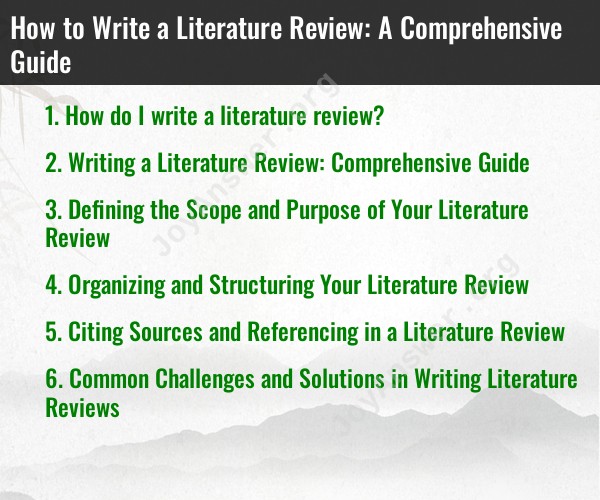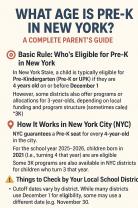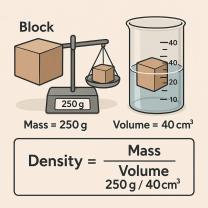How do I write a literature review?
Writing a literature review is an essential part of academic research and involves summarizing and synthesizing existing literature on a specific topic. Here's a comprehensive guide on how to write a literature review:
Define the Scope and Purpose:
- Clearly define the scope and purpose of your literature review. Determine the specific research question or topic you want to explore.
Search for Relevant Sources:
- Conduct a comprehensive search of academic databases, libraries, and online resources to find relevant sources. Use keywords, Boolean operators, and filters to refine your search.
Organize and Manage Sources:
- Keep track of your sources using citation management tools like EndNote, Mendeley, or Zotero. Create a systematic filing system to organize and store articles, books, and other materials.
Select Relevant Literature:
- Evaluate the sources you've found and select those that are most relevant to your research question. Consider the credibility, authority, and quality of the sources.
Read and Annotate Sources:
- Read the selected sources thoroughly, taking notes and annotating key points, findings, and methodologies. Organize your notes by themes, categories, or topics.
Create an Outline:
- Develop an outline for your literature review. Organize your review into sections or themes to guide your writing.
Introduction:
- Begin your literature review with an introduction that provides an overview of the topic and its importance. State your research question or purpose.
Body of the Review:
- In this section, present and analyze the literature, categorizing it into themes or topics. For each theme, summarize the key findings and concepts from the sources.
- Organize your review in a logical order, either chronologically, thematically, or methodologically, depending on your research question.
Critically Analyze the Literature:
- Offer a critical analysis of the literature. Compare and contrast different studies, identifying patterns, gaps, inconsistencies, and areas where more research is needed.
- Discuss the strengths and weaknesses of the sources, highlighting the methodologies and data used.
Synthesize and Connect the Literature:
- Synthesize the findings and concepts from various sources to build a coherent narrative. Explain how the literature relates to your research question.
- Show how different studies and ideas in the literature connect and contribute to the understanding of your topic.
Highlight Gaps and Controversies:
- Identify gaps in the literature and any controversies or areas of debate. Discuss the limitations of existing research.
Conclusion:
- Summarize the main findings of your literature review and restate its significance for your research. Suggest avenues for future research.
Cite Sources:
- Properly cite all the sources you have referenced in your literature review. Follow a consistent citation style (e.g., APA, MLA, Chicago) as required by your institution.
Proofread and Edit:
- Carefully proofread and edit your literature review for clarity, coherence, and grammatical errors.
Revise and Seek Feedback:
- Review and revise your literature review based on feedback from peers, mentors, or advisors. Incorporate their suggestions to improve the quality of your review.
Formatting and Presentation:
- Format your literature review according to the style guide or guidelines provided by your academic institution or the journal you intend to submit it to.
Writing a literature review is a skill that improves with practice. It's essential to maintain a critical and analytical approach while maintaining a clear and organized structure. A well-crafted literature review is a valuable resource for both your research and for others in your field.
Sure, here is a comprehensive guide on writing a literature review, incorporating images where appropriate:
Writing a Literature Review: Comprehensive Guide
A literature review is a critical analysis of existing scholarly research on a particular topic. It serves as a foundation for further research and provides context for new studies. Writing a literature review can be a daunting task, but it is an essential skill for any researcher.
Defining the Scope and Purpose of Your Literature Review
The first step in writing a literature review is to define the scope and purpose of your review. What is your research question? What are the key concepts and terms related to your topic? What are the different perspectives on your topic? Once you have a good understanding of your topic, you can start to narrow down your focus.
Organizing and Structuring Your Literature Review
A well-organized literature review will have a clear and logical structure. The following is a common structure for literature reviews:
- Introduction: This section provides an overview of your topic and states your research question.
- Background: This section provides a summary of the existing research on your topic.
- Methodology: This section describes how you searched for and selected sources for your review.
- Findings: This section presents the key findings of your review.
- Discussion: This section discusses the implications of your findings and suggests directions for future research.
- Conclusion: This section summarizes the main points of your review.
Citing Sources and Referencing in a Literature Review
It is important to cite all sources used in your literature review. This helps to avoid plagiarism and gives credit to the original authors. There are many different citation styles, so be sure to follow the style required by your instructor or publisher.
Common Challenges and Solutions in Writing Literature Reviews
Here are some common challenges that researchers face when writing literature reviews:
- Finding relevant sources: There is a vast amount of research published on most topics, so it can be difficult to find relevant sources.
- Organizing and synthesizing information: Once you have found relevant sources, you need to be able to organize and synthesize the information into a coherent review.
- Evaluating the quality of sources: Not all sources are created equal, so it is important to be able to evaluate the quality of your sources.
Here are some solutions to these challenges:
- Use a variety of search methods: In addition to using academic databases, you can also use search engines, Google Scholar, and social media to find relevant sources.
- Create a chart or table to organize your sources: This can help you to see the relationships between different sources and to identify key themes.
- Read the abstracts and conclusions of sources first: This can help you to quickly identify whether a source is relevant to your topic.
- Be critical of your sources: Consider the author's credentials, the methodology used, and the conclusions drawn.
Writing a literature review can be a challenging task, but it is an essential skill for any researcher. By following the tips in this guide, you can write a comprehensive and well-structured literature review that will make a valuable contribution to your field.












